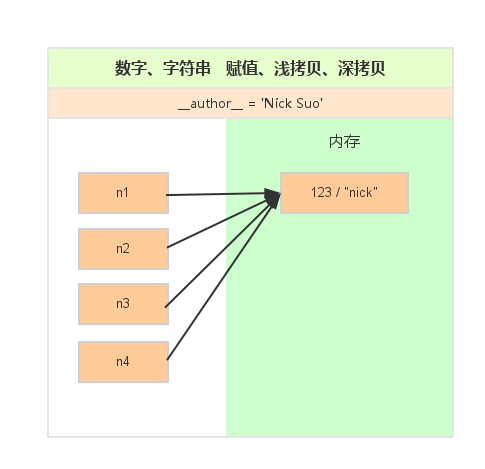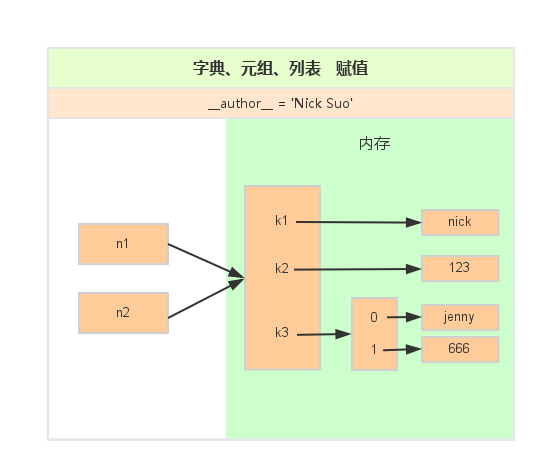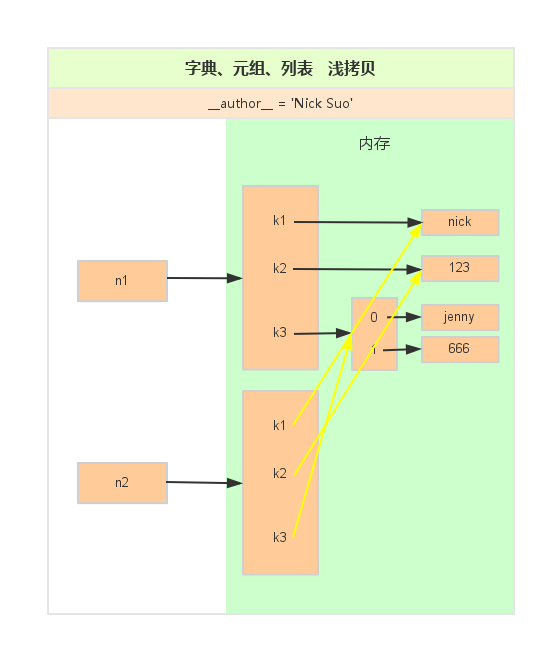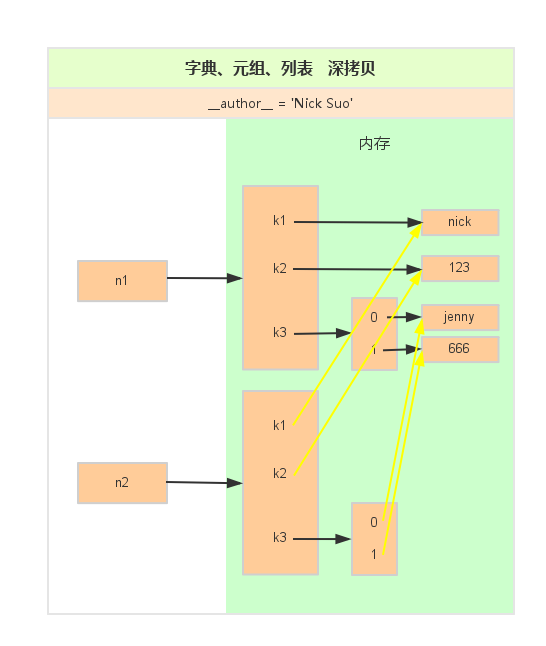Python基础(三)
本章内容:
- 深浅拷贝
- 函数(全局与局部变量)
- 文件处理
- 三元运算
- lambda 表达式
- 递归(斐波那契数列)
一、数字和字符串
对于 数字 和 字符串 而言,赋值、浅拷贝和深拷贝无意义,因为其永远指向同一个内存地址。
import copy #定义变量 数字、字符串 n1 = 123 #n1 = 'nick' print(id(n1)) #赋值 n2 = n1 print(id(n2)) #浅拷贝 n3 = copy.copy(n1) print(id(n3)) #深拷贝 n4 = copy.deepcopy(n1) print(id(n4))

二、字典、元祖、列表
对于字典、元祖、列表 而言,进行赋值、浅拷贝和深拷贝时,其内存地址的变化是不同的。
1、赋值
创建一个变量,该变量指向原来内存地址
n1 = {"k1": "nick", "k2": 123, "k3": ["jenny", 666]} n2 = n1 
2、浅拷贝
在内存中只额外创建第一层数据
import copy n1 = {"k1": "nick", "k2": 123, "k3": ["jenny", 666]} n2 = copy.copy(n1) 
3、深拷贝
在内存中将所有的数据重新创建一份(排除最后一层,即:python内部对字符串和数字的优化)
import copy n1 = {"k1": "nick", "k2": 123, "k3": ["jenny", 666]} n2 = copy.deepcopy(n1) 
一、定义和使用
函数式编程最重要的是增强代码的重用性和可读性
def 函数名(参数): ... 函数体 ... 返回值
函数的定义主要有如下要点:
- def:表示函数的关键字
- 函数名:函数的名称,日后根据函数名调用函数
- 函数体:函数中进行一系列的逻辑计算
- 参数:为函数体提供数据
- 返回值:当函数执行完毕后,可以给调用者返回数据。
1、返回值
def 发送邮件(): 发送邮件的代码... if 发送成功: return True else: return False while True: # 每次执行发送邮件函数,都会将返回值自动赋值给result # 之后,可以根据result来写日志,或重发等操作 result = 发送邮件() if result == False: 记录日志,邮件发送失败...
2、参数
函数的有三中不同的参数:
- 普通参数
- 默认参数
- 动态参数
#定义函数 #n 叫做函数 name 的形式参数,简称:形参 def name(n): print(n) #执行函数 #'nick' 叫做函数 name 的实际参数,简称:实参 name('nick') 普通参数 def func(name, age = 18): print("%s:%s")%(name,age) # 指定参数 func('nick', 19) # 使用默认参数 func('nick') 注:默认参数需要放在参数列表最后 默认参数 def func(*args): print args # 执行方式一 func(11,22,33,55,66) # 执行方式二 li = [11,22,33,55,66] func(*li) 动态参数(*args)
def func(**kwargs): print kwargs # 执行方式一 func(name='nick',age=18) # 执行方式二 li = {'name':'nick', age:18, 'job':'pythoner'} func(**li) 动态参数(**kwargs) def hi(a,*args,**kwargs): print(a,type(a)) print(args,type(args)) print(kwargs,type(kwargs)) hi(11,22,33,k1='nick',k2='jenny') 动态参数(a,*args,**kwargs)
#发送邮件实例
def mail(主题,邮件内容='test',收件人='630571017@qq.com'): import smtplib from email.mime.text import MIMEText from email.utils import formataddr msg = MIMEText(邮件内容, 'plain', 'utf-8') msg['From'] = formataddr(["发件人", '发件人地址']) msg['To'] = formataddr(["收件人", '630571017@qq.com']) msg['Subject'] = 主题 server = smtplib.SMTP("smtp.126.com", 25) server.login("登录邮箱账号", "邮箱密码") server.sendmail('发件邮箱地址账号', [收件人地址, ], msg.as_string()) server.quit() mail('我是主题',收件人='630571017@qq.com',邮件内容='邮件内容') mail(主题='我是主题',) 发送邮件实例 3、全局与局部变量
全局变量在函数里可以随便调用,但要修改就必须用 global 声明
############### 全 局 与 局 部 变 量 ############## #全局变量 P = 'nick' def name(): global P #声明修改全局变量 P = 'jenny' #局部变量 print(P) def name2(): print(P) name() name2()
open函数 ,该函数用于文件处理
一、打开文件
文件句柄 = open('文件路径', '模式') 打开文件时,需要指定文件路径和以何等方式打开文件,打开后,即可获取该文件句柄,日后通过此文件句柄对该文件操作。
打开文件的模式有:
- r ,只读模式【默认】
- w,只写模式【不可读;不存在则创建;存在则清空内容;】
- x, 只写模式【不可读;不存在则创建,存在则报错】
- a, 追加模式【可读; 不存在则创建;存在则只追加内容;】
"+" 表示可以同时读写某个文件
- r+, 读写【可读,可写】
- w+,写读【可读,可写】
- x+ ,写读【可读,可写】
- a+, 写读【可读,可写】
"b"表示以字节的方式操作
- rb 或 r+b
- wb 或 w+b
- xb 或 w+b
- ab 或 a+b
注:以b方式打开时,读取到的内容是字节类型,写入时也需要提供字节类型
二、操作
class file(object) def close(self): # real signature unknown; restored from __doc__ 关闭文件 """ close() -> None or (perhaps) an integer. Close the file. Sets data attribute .closed to True. A closed file cannot be used for further I/O operations. close() may be called more than once without error. Some kinds of file objects (for example, opened by popen()) may return an exit status upon closing. """ def fileno(self): # real signature unknown; restored from __doc__ 文件描述符 """ fileno() -> integer "file descriptor". This is needed for lower-level file interfaces, such os.read(). """ return 0 def flush(self): # real signature unknown; restored from __doc__ 刷新文件内部缓冲区 """ flush() -> None. Flush the internal I/O buffer. """ pass def isatty(self): # real signature unknown; restored from __doc__ 判断文件是否是同意tty设备 """ isatty() -> true or false. True if the file is connected to a tty device. """ return False def next(self): # real signature unknown; restored from __doc__ 获取下一行数据,不存在,则报错 """ x.next() -> the next value, or raise StopIteration """ pass def read(self, size=None): # real signature unknown; restored from __doc__ 读取指定字节数据 """ read([size]) -> read at most size bytes, returned as a string. If the size argument is negative or omitted, read until EOF is reached. Notice that when in non-blocking mode, less data than what was requested may be returned, even if no size parameter was given. """ pass def readinto(self): # real signature unknown; restored from __doc__ 读取到缓冲区,不要用,将被遗弃 """ readinto() -> Undocumented. Don't use this; it may go away. """ pass def readline(self, size=None): # real signature unknown; restored from __doc__ 仅读取一行数据 """ readline([size]) -> next line from the file, as a string. Retain newline. A non-negative size argument limits the maximum number of bytes to return (an incomplete line may be returned then). Return an empty string at EOF. """ pass def readlines(self, size=None): # real signature unknown; restored from __doc__ 读取所有数据,并根据换行保存值列表 """ readlines([size]) -> list of strings, each a line from the file. Call readline() repeatedly and return a list of the lines so read. The optional size argument, if given, is an approximate bound on the total number of bytes in the lines returned. """ return [] def seek(self, offset, whence=None): # real signature unknown; restored from __doc__ 指定文件中指针位置 """ seek(offset[, whence]) -> None. Move to new file position. Argument offset is a byte count. Optional argument whence defaults to (offset from start of file, offset should be >= 0); other values are 1 (move relative to current position, positive or negative), and 2 (move relative to end of file, usually negative, although many platforms allow seeking beyond the end of a file). If the file is opened in text mode, only offsets returned by tell() are legal. Use of other offsets causes undefined behavior. Note that not all file objects are seekable. """ pass def tell(self): # real signature unknown; restored from __doc__ 获取当前指针位置 """ tell() -> current file position, an integer (may be a long integer). """ pass def truncate(self, size=None): # real signature unknown; restored from __doc__ 截断数据,仅保留指定之前数据 """ truncate([size]) -> None. Truncate the file to at most size bytes. Size defaults to the current file position, as returned by tell(). """ pass def write(self, p_str): # real signature unknown; restored from __doc__ 写内容 """ write(str) -> None. Write string str to file. Note that due to buffering, flush() or close() may be needed before the file on disk reflects the data written. """ pass def writelines(self, sequence_of_strings): # real signature unknown; restored from __doc__ 将一个字符串列表写入文件 """ writelines(sequence_of_strings) -> None. Write the strings to the file. Note that newlines are not added. The sequence can be any iterable object producing strings. This is equivalent to calling write() for each string. """ pass def xreadlines(self): # real signature unknown; restored from __doc__ 可用于逐行读取文件,非全部 """ xreadlines() -> returns self. For backward compatibility. File objects now include the performance optimizations previously implemented in the xreadlines module. """ pass 2.x
class TextIOWrapper(_TextIOBase): """ Character and line based layer over a BufferedIOBase object, buffer. encoding gives the name of the encoding that the stream will be decoded or encoded with. It defaults to locale.getpreferredencoding(False). errors determines the strictness of encoding and decoding (see help(codecs.Codec) or the documentation for codecs.register) and defaults to "strict". newline controls how line endings are handled. It can be None, '', '/n', '/r', and '/r/n'. It works as follows: * On input, if newline is None, universal newlines mode is enabled. Lines in the input can end in '/n', '/r', or '/r/n', and these are translated into '/n' before being returned to the caller. If it is '', universal newline mode is enabled, but line endings are returned to the caller untranslated. If it has any of the other legal values, input lines are only terminated by the given string, and the line ending is returned to the caller untranslated. * On output, if newline is None, any '/n' characters written are translated to the system default line separator, os.linesep. If newline is '' or '/n', no translation takes place. If newline is any of the other legal values, any '/n' characters written are translated to the given string. If line_buffering is True, a call to flush is implied when a call to write contains a newline character. """ def close(self, *args, **kwargs): # real signature unknown 关闭文件 pass def fileno(self, *args, **kwargs): # real signature unknown 文件描述符 pass def flush(self, *args, **kwargs): # real signature unknown 刷新文件内部缓冲区 pass def isatty(self, *args, **kwargs): # real signature unknown 判断文件是否是同意tty设备 pass def read(self, *args, **kwargs): # real signature unknown 读取指定字节数据 pass def readable(self, *args, **kwargs): # real signature unknown 是否可读 pass def readline(self, *args, **kwargs): # real signature unknown 仅读取一行数据 pass def seek(self, *args, **kwargs): # real signature unknown 指定文件中指针位置 pass def seekable(self, *args, **kwargs): # real signature unknown 指针是否可操作 pass def tell(self, *args, **kwargs): # real signature unknown 获取指针位置 pass def truncate(self, *args, **kwargs): # real signature unknown 截断数据,仅保留指定之前数据 pass def writable(self, *args, **kwargs): # real signature unknown 是否可写 pass def write(self, *args, **kwargs): # real signature unknown 写内容 pass def __getstate__(self, *args, **kwargs): # real signature unknown pass def __init__(self, *args, **kwargs): # real signature unknown pass @staticmethod # known case of __new__ def __new__(*args, **kwargs): # real signature unknown """ Create and return a new object. See help(type) for accurate signature. """ pass def __next__(self, *args, **kwargs): # real signature unknown """ Implement next(self). """ pass def __repr__(self, *args, **kwargs): # real signature unknown """ Return repr(self). """ pass buffer = property(lambda self: object(), lambda self, v: None, lambda self: None) # default closed = property(lambda self: object(), lambda self, v: None, lambda self: None) # default encoding = property(lambda self: object(), lambda self, v: None, lambda self: None) # default errors = property(lambda self: object(), lambda self, v: None, lambda self: None) # default line_buffering = property(lambda self: object(), lambda self, v: None, lambda self: None) # default name = property(lambda self: object(), lambda self, v: None, lambda self: None) # default newlines = property(lambda self: object(), lambda self, v: None, lambda self: None) # default _CHUNK_SIZE = property(lambda self: object(), lambda self, v: None, lambda self: None) # default _finalizing = property(lambda self: object(), lambda self, v: None, lambda self: None) # default 3.x
三、管理上下文
为了避免打开文件后忘记关闭,可以通过管理上下文,即:
with open('log','r') as f: ... 如此方式,当with代码块执行完毕时,内部会自动关闭并释放文件资源。
在Python 2.7 及以后,with又支持同时对多个文件的上下文进行管理,即:
with open('log1') as obj1, open('log2') as obj2: pass 三元运算(三目运算),是对简单的条件语句的缩写。
result = 值1 if 条件 else 值2 # 如果条件成立,那么将 “值1” 赋值给result变量,否则,将“值2”赋值给result变量
########## 三 元 运 算 ############ name = "nick" if 1==1 else "jenny" print(name)
对于简单的函数,存在一种简便的表示方式,即:lambda表达式
######## 普 通 函 数 ######## # 定义函数(普通方式) def func(arg): return arg + 1 # 执行函数 result = func(123) ######## lambda 表 达 式 ######## # 定义函数(lambda表达式) my_lambda = lambda arg : arg + 1 # 执行函数 result = my_lambda(123)
- 递归就是在过程或函数里调用自身。
- 在使用递归策略时,必须有一个明确的递归结束条件,称为递归出口。
- 递归算法解题通常显得很简洁,但递归算法解题的运行效率较低。所以一般不提倡用递归算法设计程序。
- 在 递归调用 的过程当中系统为每一层的返回点、局部量等开辟了栈来存储。递归次数过多容易造成 栈溢出 等。所以一般不提倡用递归算法设计程序。
利用函数编写如下数列:
斐波那契数列指的是这样一个数列 0, 1, 1, 2, 3, 5, 8, 13, 21, 34, 55, 89, 144, 233,377,610,987,1597,2584,4181,6765,10946,17711,28657,46368...
def func(arg1,arg2): if arg1 == 0: print arg1, arg2 arg3 = arg1 + arg2 print arg3 func(arg2, arg3) func(0,1)
#写函数,利用递归获取斐波那契数列中的第 10 个数 def fie(n): if n == 0 or n == 1: return n else: return (fie(n-1)+fie(n-2)) set = fie(10) print(set)











![[HBLOG]公众号](https://www.liuhaihua.cn/img/qrcode_gzh.jpg)

